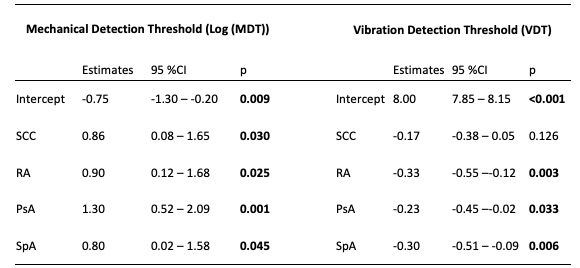Session Information
Date: Sunday, November 12, 2023
Title: (0609–0672) Systemic Sclerosis & Related Disorders – Clinical Poster I: Research
Session Type: Poster Session A
Session Time: 9:00AM-11:00AM
Background/Purpose: Pain is a prominent symptom in numerous rheumatological diseases. In order to allow for a standardized quantification and the assessment of nociceptive and non-nociceptive submodalities of various afferent nerve fiber groups and central pathways, and to identify sensitive plus or minus signs like hyperalgesia or hypesthesia, the “Quantitative Sensory Testing” (QST) protocol was developed. This tool, established by the German Neuropathic Pain Research Network (DFNS), generates somatosensory profiles [1]that can serve as a valuable tool for guiding targeted pain management strategies. This study investigates variations in somatosensory profiles between healthy individuals and patients with rheumatoid arthritis (RA), psoriatic arthritis (PsA), axial spondyloarthritis (SpA), systemic sclerosis (SSc).
Methods: Twenty patients of each disease group (RA, PsA, SpA and SSc) and 20 healthy individuals were enrolled in this monocentric five-armed study, which received ethical approval under Institutional Review Board #065/20. Each of the 100 participants underwent the standardized QST procedure for the creation of a somatosensory profile. QST included both small fiber mediated stimuli and large fiber mediated stimuli incorporating all categories depicted in figure 1. Additional clinical data (including laboratory values, joint manifestations, and pain and disease activity assessments) was collected via standardized questionnaires (BASDAI, PASDAS, CDAI and mRSS). Data was analyzed by using linear modelling and standardized z-scores.
Results: A preliminary data analysis of all 100 study participants was performed. As shown in figure 2, all patient groups presented with increased mechanical detection thresholds (p≤0.045 for RA, PsA, SpA and SSc). Furthermore, RA, PsA and SpA patients showed diminished vibration perception (p≤0.033 for RA, PsA and SpA). A higher prevalence of allodynia was seen in all patient groups, as in 5% of patients with SSc, 15% of RA, 25% of PsA, and 15% of all SpA patients, compared with 0% in the control group.
Additionally, the study showed that people with systemic sclerosis notice cold and cold pain stimuli much earlier than healthy individuals (p=0.023).
Conclusion: Allodynia, mechanical detection and vibration are perceived through A β-fibers. Considering that all these three modalities showed deviations within the somatosensory profiles, A β-fibers seem to be most severely affected from rheumatological diseases. Accordingly, further research on the role of A β-fibers, particularly in allodynia, is thought to be supportive in the improvement of targeted and personalized pain management. Systemic sclerosis patients’ particular susceptibility to cold stimuli is explained given the presence of Raynaud’s syndrome.
(1) Cold detection threshold, (2) Warm detection threshold, (3) Thermal sensory limen, (4) Paradoxical heat sensations, (5) Cold pain threshold, (6) Heat pain threshold, (7) Mechanical pain threshold, (8) Mechanical pain sensitivity, (9) Wind-up-Ratio, (10) Pain pressure threshold, (11) Allodynia, (12) Vibration detection threshold, (13) Mechanical detection threshold
To cite this abstract in AMA style:
Bauer C, Schrapper R, Petzinna S, Behning C, Bender T, Brossart P, Muecke M, Schäfer V. Chasing Pain: Investigating Somatosensory Profiles in Patients with Rheumatological Diseases Using Quantitative Sensory Testing [abstract]. Arthritis Rheumatol. 2023; 75 (suppl 9). https://acrabstracts.org/abstract/chasing-pain-investigating-somatosensory-profiles-in-patients-with-rheumatological-diseases-using-quantitative-sensory-testing/. Accessed .« Back to ACR Convergence 2023
ACR Meeting Abstracts - https://acrabstracts.org/abstract/chasing-pain-investigating-somatosensory-profiles-in-patients-with-rheumatological-diseases-using-quantitative-sensory-testing/


